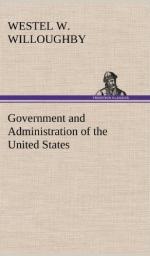This ordinance provided that the whole of this territory should form one district. At first Congress appointed the governor, secretary, judges, and military generals. The governor was to make the laws, subject to the approval of Congress. When the population reached five thousand the inhabitants were to have a legislature of their own, and to have a delegate who should sit in Congress, but have no vote. There was a bill of rights. Public education was encouraged. Not less than three nor more than five States were to be formed from it. Ohio, Indiana, Illinois, Michigan, and Wisconsin have been the five States formed from this territory. The transformation of the territory into States was promised as soon as the population should reach sixty thousand.
Slavery was forever prohibited in all this territory. We shall see the tremendous importance of this clause, which guaranteed to this large tract freedom from the curse of slavery, when we come to consider the struggles which were made for many years to keep slavery from the territories.
CHAPTER XIII.
Government of the Territories.
There are at present four areas, situated outside of the States, and organized under territorial governments. These are Utah, Arizona, New Mexico and Oklahoma. Besides these there are the two unorganized territories, Indian Territory, and Alaska, and the District of Columbia, which last tract contains sixty-four square miles.
_#Government of Territories.#_—The fundamental law of a Territory is the Federal Constitution, just as in a State. Unlike the State, however, it has no constitution of its own, but is regulated entirely by Congress. In Section 3, Article IV, of the Constitution, it is declared that “Congress shall have power to dispose of and make all needful regulations respecting the territory or other property belonging to the United States.” In pursuance of this clause Congress has in the four organized Territories instituted governments as follows: The executive of the Territory is a Governor appointed by the President for a four years’ term. There is also a secretary and treasurer. The legislature consists of two houses, a council of 12, and a House of Representatives of 24. These are elected by the people of the Territories, and have a term of two years. The Legislature meets every other year. All its acts require approval by Congress before becoming law.
The judiciary consists of three or more judges appointed by the President, together with a district attorney and United States marshal.
Territories send neither Senators nor Representatives to Congress, but have one delegate apiece in the United States House of Representatives, who may speak, but not vote.
_#Admission of a Territory as a State.#_—A Territory is an embryo State. As soon as a Territory becomes sufficiently populated it applies for admission into the Union as a State, and such admission is accomplished in the following manner. When an application by a Territory for Statehood is made, it is considered by Congress, and, if approved, the inhabitants of the Territory are authorized to form for themselves out of such Territory a State government, and thus prepare themselves for admission into the Union.




